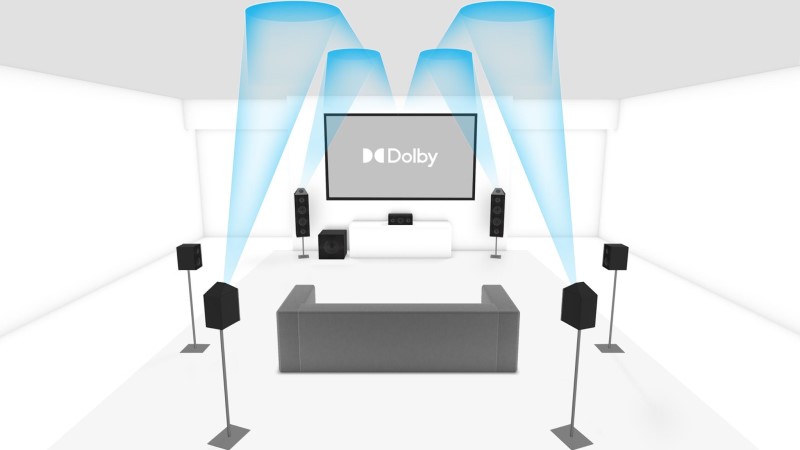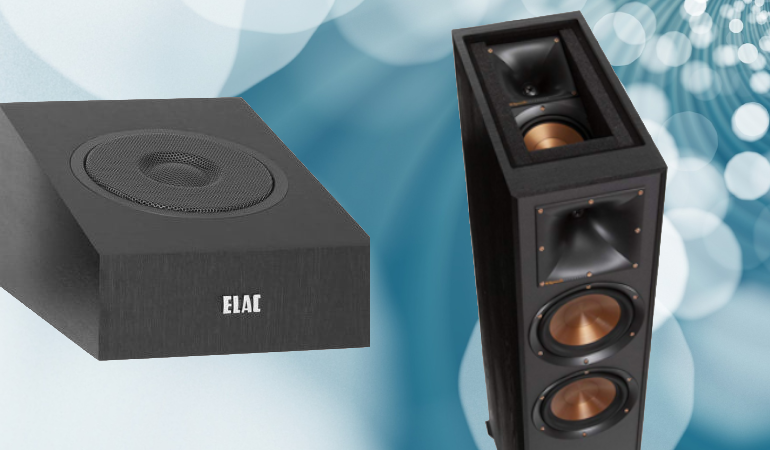How Do Upfiring Atmos Speakers Work
Upfiring Atmos speakers are some of the most divisive speakers currently on the market. They take two forms – standalone upfiring speakers and speakers built into the top of another speaker (see image above). You’ll read people raving about them and others that say that they do less than nothing. So, do upfiring Atmos speakers work? Let’s discuss!
What is the Theory of Upfiring Atmos Speakers?
The design of an upfiring Atmos speaker seems very intuitive. The speakers are angled so that the sound bounces off the ceiling and returns to the listener from above. This gives the listener the overhead sound experience without having to install speakers in the ceiling.
But a few moments of contemplation will leave people with questions. How can upfiring Atmos speakers work when the manufacturer doesn’t know the height of your ceiling? What if the ceiling is angled? Does that change things? What if you have a textured or a drop ceiling? Will these cause the upfiring Atmos speakers not to work as well?
All good questions which explain why some people say they work very well and others say they don’t work at all.

How Upfiring Atmos Speakers Actually Work
Sound designers can alter the phase of a sound so that it tricks our ears (brains really) into thinking a sound is coming from somewhere it is not. It has already been revealed that upfiring Dolby Atmos speakers have an HRTF integrated into their design. An HRTF (or Head Related Transfer Function) is essentially modifying the sounds that would have come from overhead speakers. This changes how they sound in an effort to make them sound more like they are placed on the ceiling.
When an upfiring Atmos speaker plays a sound, you hear it twice. Once directly from the speaker, and the second time as the sound bounces off the ceiling. The HRTF is modifying the sound so that your brain will be more convinced that the sound is coming from above. But not all of the sound is. So how does that work?
Positioning Is Key
The easy answer is not very well. If you sit too close to the upfiring Atmos speaker, the direct sound will be louder than the bounced sound. You will be more likely to perceive that sound as coming from the speaker, not the bounce. If you sit too far away, the bounced sound will be more delayed and have less energy (volume) and you’ll perceive the sound as coming directly from the speaker. The HRTF will try and counteract this, but there is no telling how effective it will be.
So, essentially there is a perfect seating distance from the speaker. Close enough that the reflected sound is loud enough but not too close. What is that distance? We can’t tell you! It has to do with the height of your ceilings, how reflective the ceiling is, and the placement of your upfiring Atmos speakers.
Take Away
When giving advice about upfiring Atmos speakers, it is easiest to say that they don’t work. That’s because most people won’t have the will or flexibility to place them so that they can work well in their space. If you’ve bought upfiring Atmos speakers and they work well, then you’ve gotten very lucky. Most people find upfiring Atmos speakers very underwhelming simply because they don’t have them placed correctly or their room doesn’t easily support them. If you can’t install in-ceiling speakers, and you want Atmos, upfiring speakers can work fairly well. You just have to be willing to experiment with their placement.


